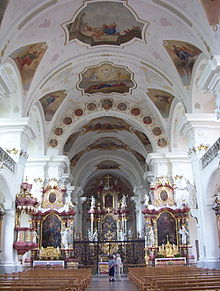Vorarlberg Cathedral Scheme
The Vorarlberg Cathedral Scheme is a form of church building that was developed by the Auer Guild towards the end of the 17th century and was particularly popular in southern Germany , Austria , Switzerland and Alsace .
In the Vorarlberg scheme, the nave is reduced to a nave, which is supported by rows of pillars widened to the outer wall ( wall pillar church ). There are chapels between the pillars . Together with the galleries above, the building inside gives the impression of a gallery basilica . The ceiling is usually designed as a barrel vault . The transept is only slightly overhanging; the choir mostly takes up the shape of the nave.
The Roman baroque church Il Gesù (1568–84) and its successor buildings north of the Alps, such as St. Michael in Munich, are considered to be the most important model of the hardly variable Vorarlberg cathedral scheme .
Prominent representatives of this construction method were the master builder families Thumb ( Peter Thumb and others), Beer ( Johann Michael Beer and others) and Moosbrugger ( Caspar Moosbrugger ) from Au (Vorarlberg) .
Examples
- Ellwangen , pilgrimage church on the Schönenberg , 1681–96 (earliest example)
- Disentis Monastery , 1683 and 1704
- Irsee Monastery Church , 1699–1704
- St. Martin (Tannheim) , 1700–1702
- Marchtal Monastery, St. Peter and Paul Monastery Church, 1686–92
- Hofen monastery , monastery church (today: Friedrichshafen Castle Church), 1695–1701
- Rheinau Abbey , abbey church, 1704–11
- Ebersmünster Abbey (Alsace), abbey church, 1710–15
- St. Urban Monastery , Monastery Church, 1711–15
- Weingarten Abbey , former St. Martin monastery church ("Basilica"), 1715–1724
- Weißenau Monastery , former monastery church, 1717–1724
- Monastery of St. Peter in the Black Forest , monastery church, 1724–27
- Zwiefalten Monastery , former monastery church, 1739–65
The cathedral scheme was later also applied to secular spaces:
- St. Gallen Abbey Library, library room (1758–1767)
- St. Peter's Monastery in the Black Forest , library room (1738)

